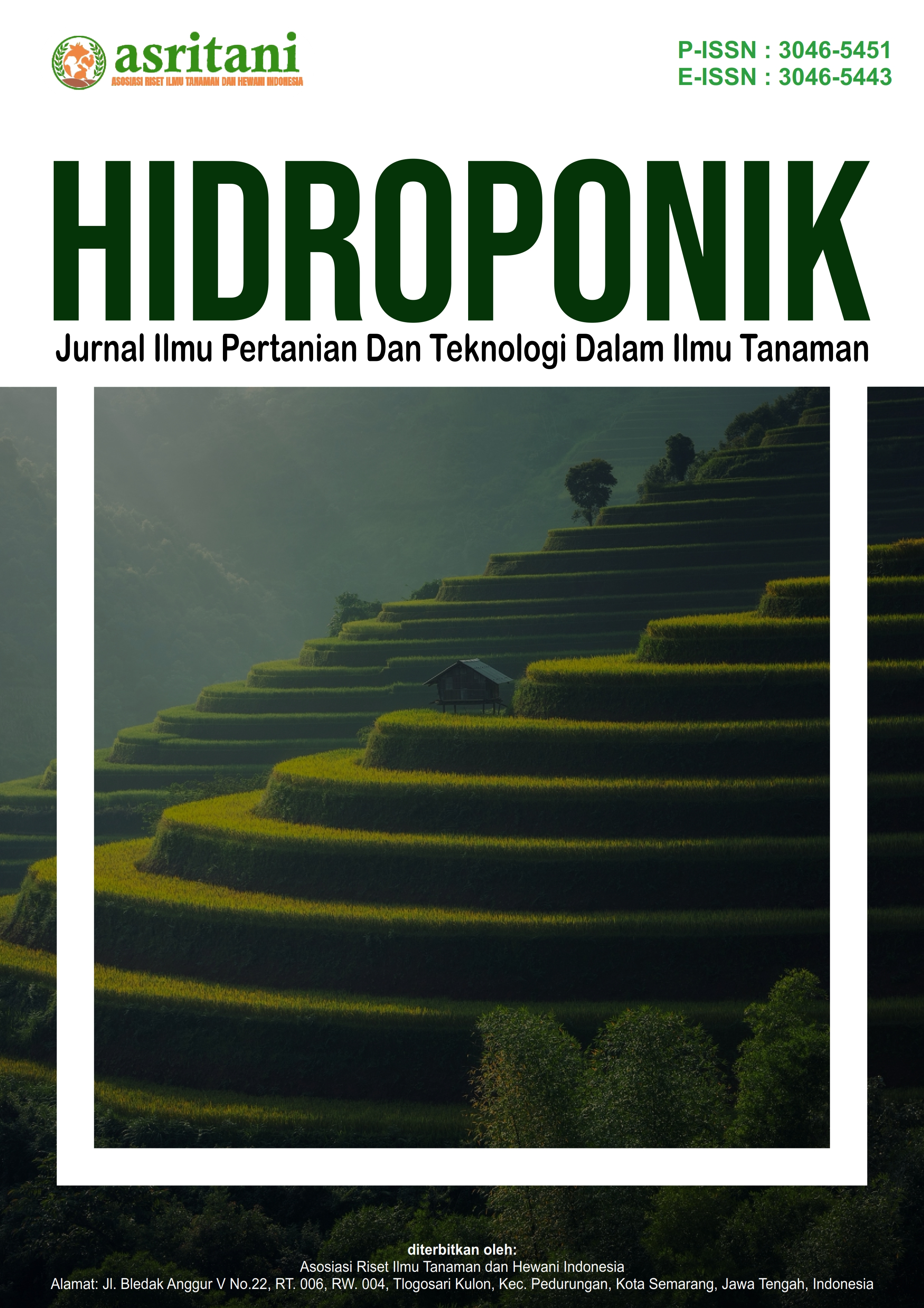Analisis Peran Teknologi IoT dalam Praktik Regeneratif Soil Management: Studi Kualitatif atas Best Practices Global
DOI:
https://doi.org/10.62951/hidroponik.v2i2.380Keywords:
IoT, Soil, Regenerative, Agriculture, SustainabilityAbstract
This qualitative study analyzes the role of Internet of Things (IoT) technology in regenerative soil management practices, focusing on global best practices that can be replicated in Indonesia. As a vital resource, soil plays a crucial role in supporting agricultural productivity and food security, yet it faces significant threats from degradation due to unsustainable agricultural practices and chemical overuse. The study emphasizes the importance of integrating IoT technology to monitor and manage soil conditions in real-time, enhancing decision-making for sustainable agriculture. Key questions addressed include how IoT supports regenerative practices, examples of successful global implementations, and the effectiveness of IoT in improving soil quality and organic carbon content. Findings highlight that IoT can significantly enhance soil health by enabling precise monitoring of key parameters such as moisture, pH, and temperature, thereby facilitating timely interventions. The research also explores the challenges and opportunities associated with IoT adoption in regenerative agriculture, particularly in developing countries. Ultimately, the integration of IoT in regenerative soil management presents a promising pathway to achieving sustainable agricultural practices that meet the growing global food demands while restoring ecosystem health.
References
Abbasi, M., Yaghmaee, M. H., & Rahnama, F. (2019). Internet of things in agriculture: A survey. 2019 3rd International Conference on Internet of Things and Applications (IoT), 1–12. https://doi.org/10.1109/IICITA.2019.8808839
Adiningsih, J. S. (1989). Evaluasi keperluan fosfat pada lahan sawah intensifikasi di Jawa. Dalam Prosiding Lokakarya Nasional Penggunaan Pupuk, Cipayung, 25 November 1988 (hlm. 63–89).
Alabdeli, H., Obaid, M. K., & C, V. K. (2025). Implementing soil health improvement techniques in regenerative agriculture using IoT-enabled NPK sensing for precision nutrient management. [Artikel konferensi, tidak lengkap].
Aliyah, N., Murthiningtyas, N. H., Almas, S. S., & Purnomo, D. E. (2025). Tantangan dan peluang penggunaan IoT pada agrokompleks: Systematic literature review. JATI (Jurnal Mahasiswa Teknik Informatika), 9(1), 1216–1223.
Bachhav, S. S., Deshmukh, A. A., Kotangale, L. G., Shaniware, Y. A., & Bhise, R. K. (2024). Smart agriculture: IoT-driven soil nutrient management system. Journal of Agriculture and Ecology Research International, 25(6), 169–175. https://doi.org/10.9734/jaeri/2024/v25i6650
Cahyani, M. P. (2023). IoT dalam smart farming 4.0 untuk upaya tingkatkan efesiensi agribisnis. Teknois: Jurnal Ilmiah Teknologi Informasi dan Sains, 3(2), 154–190.
Choubey, A., Wadhwa, S., Ayam, J., Arya, H., & Keshari, A. (2024). IoT-based soil monitoring system & crop management. International Journal of Creative Research Thought, 12(4).
Fauzi, A. (2019). Teknik analisis keberlanjutan. Jakarta: Gramedia Pustaka Utama.
Fitriawan, H., Cahyo, K. A. D., Purwiyanti, S., & Alam, S. (2020). Pengendalian suhu dan kelembaban pada budidaya jamur tiram berbasis IoT. Jurnal Teknik Pertanian Lampung, 9(1), 28–37.
Forest Digest. (2022, April 30). PBB: 40% lahan dunia terdegradasi. Forest Digest. https://www.forestdigest.com/detail/1707/pbb-40-lahan-dunia-terdegradasi
Geoderma. (2018). Soil management. ScienceDirect. https://www.sciencedirect.com/topics/agricultural-and-biological-sciences/soil-management
Guo, M. (2021). Soil health assessment and management: Recent development in science and practices. Soil Systems, 5(4). https://doi.org/10.3390/soilsystems5040061
Khangura, R., Ferris, D., Wagg, C., & Bowyer, J. (2023). Regenerative agriculture—A literature review on the practices and mechanisms used to improve soil health. Sustainability, 15(3), 2338.
Komaludin, D. (2018). Penerapan teknologi Internet of Thing (IoT) pada bisnis budidaya tanaman hidroponik sebagai langkah efisiensi biaya perawatan. Prosiding FRIMA (Festival Riset Ilmiah Manajemen dan Akuntansi), (1), 682–690.
Lal, R. (2004). Soil carbon sequestration impacts on global climate change and food security. Science, 304(5677), 1623–1627.
Mahajan, G., Mahajan, G., & Chauhan, B. S. (2016). Effect of organic manure application on availability and uptake of phosphorus by rice and wheat in vertisol. Journal of the Indian Society of Soil Science, 64(2), 171–177.
Maharani, T. (2024). Upaya peningkatan kesehatan tanah dengan penggunaan pupuk organik dalam bingkai pertanian berkelanjutan (hlm. 103–115). [Publikasi tidak disebutkan].
Mautuka, Z. A., Astriana, M., & Martasiana, K. (2022). Pemanfaatan biochar tongkol jagung guna perbaikan sifat kimia tanah lahan kering. Jurnal Ilmiah Wahana Pendidikan, 8(1), 201–208. https://doi.org/10.5281/zenodo.5827375
Moebius-Clune, B. N., Moebius-Clune, D. J., Gugino, B. K., Idowu, O. J., Schindelbeck, R. R., Ristow, A. J., Van Es, H. M., Thies, J. E., Shayler, H. A., McBride, M. B., Wolfe, D. W., & Abawi, G. S. (2016). Comprehensive assessment of soil health (3rd ed.). Cornell University.
Muda, H. B., Ermilinda, L., & Lodan, M. W. (2025). Aplikasi mobile untuk menentukan tingkat kesuburan tanah dan kesesuaian tanaman dengan metode fuzzy logic menggunakan IoT. Innovative: Journal of Social Science Research, 5(2), 1983–1993.
Nuryadi, F., Septiani, N. W. P., & Lestari, M. (2025). Implementasi ESP32 untuk sistem pemantauan kesuburan tanah berbasis IoT. Seminar Nasional Riset dan Inovasi Teknologi (SEMNAS RISTEK), 79–86.
Purnama, A. C., Rahayu, S. N., & Dirgantara, S. T. (2024, Oktober). Achievements of climate smart agriculture practices in horticultural agriculture in the Tawangargo smart eco-farming village program. Dalam E-Proceeding Conference: Indonesia Social Responsibility Award, 2(5).
Putra, R. A., & Kurniawan, D. (2020). Rancang bangun sistem irigasi otomatis berbasis Internet of Things (IoT) pada lahan pertanian. Jurnal Teknologi Pertanian, 21(1), 45–52.
Ridley, D. (2012). The literature review: A step-by-step guide for students (2nd ed., K. Metzler, Ed.). London, UK: SAGE Publications Ltd.
Riwandi. (2010). Identifikasi dan interpretasi indikator kesehatan tanah. Makalah Seminar Nasional dan Kongres Masyarakat Konservasi Tanah dan Air Indonesia (MKTI), 24–25 November 2010, Jambi. https://repository.unib.ac.id/144/1/Kum_B11_Riwandi.pdf
Riwandi. (2011). Metode cepat penilaian kesehatan tanah dengan indikator kinerja tanah. Dalam Seminar Nasional dan Rapat Tahunan Dekan Bidang Ilmu-Ilmu Pertanian, 23–25 Mei 2011, Palembang. https://repository.unib.ac.id/145/
Sari, I. P., Novita, A., Al-Khowarizmi, A. K., Ramadhani, F., & Satria, A. (2024). Pemanfaatan Internet of Things (IoT) pada bidang pertanian menggunakan Arduino Uno R3. Blend Sains: Jurnal Teknik, 2(4), 337–343.
Sugiyono. (2013). Metodologi penelitian kuantitatif kualitatif dan R&D. Bandung: Alfabeta.
Yuwono, E., & Yukamgo, N. W. (2007). Peran silikon sebagai unsur bermanfaat pada tanaman tebu. Jurnal Ilmu Tanah dan Lingkungan, 7(2), 103–116.
Downloads
Published
How to Cite
Issue
Section
License
Copyright (c) 2025 Hidroponik : Jurnal Ilmu Pertanian Dan Teknologi Dalam Ilmu Tanaman

This work is licensed under a Creative Commons Attribution-ShareAlike 4.0 International License.





